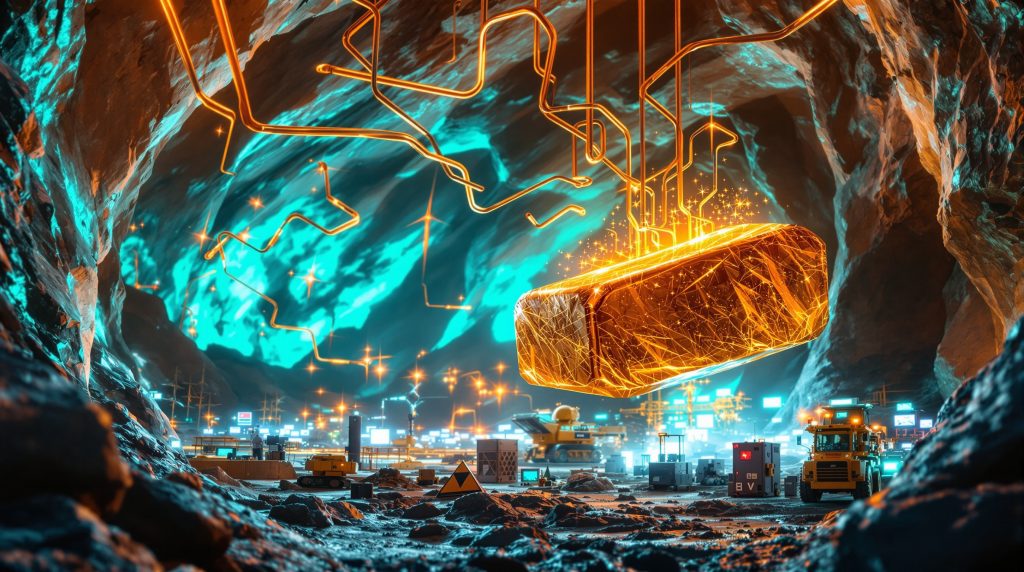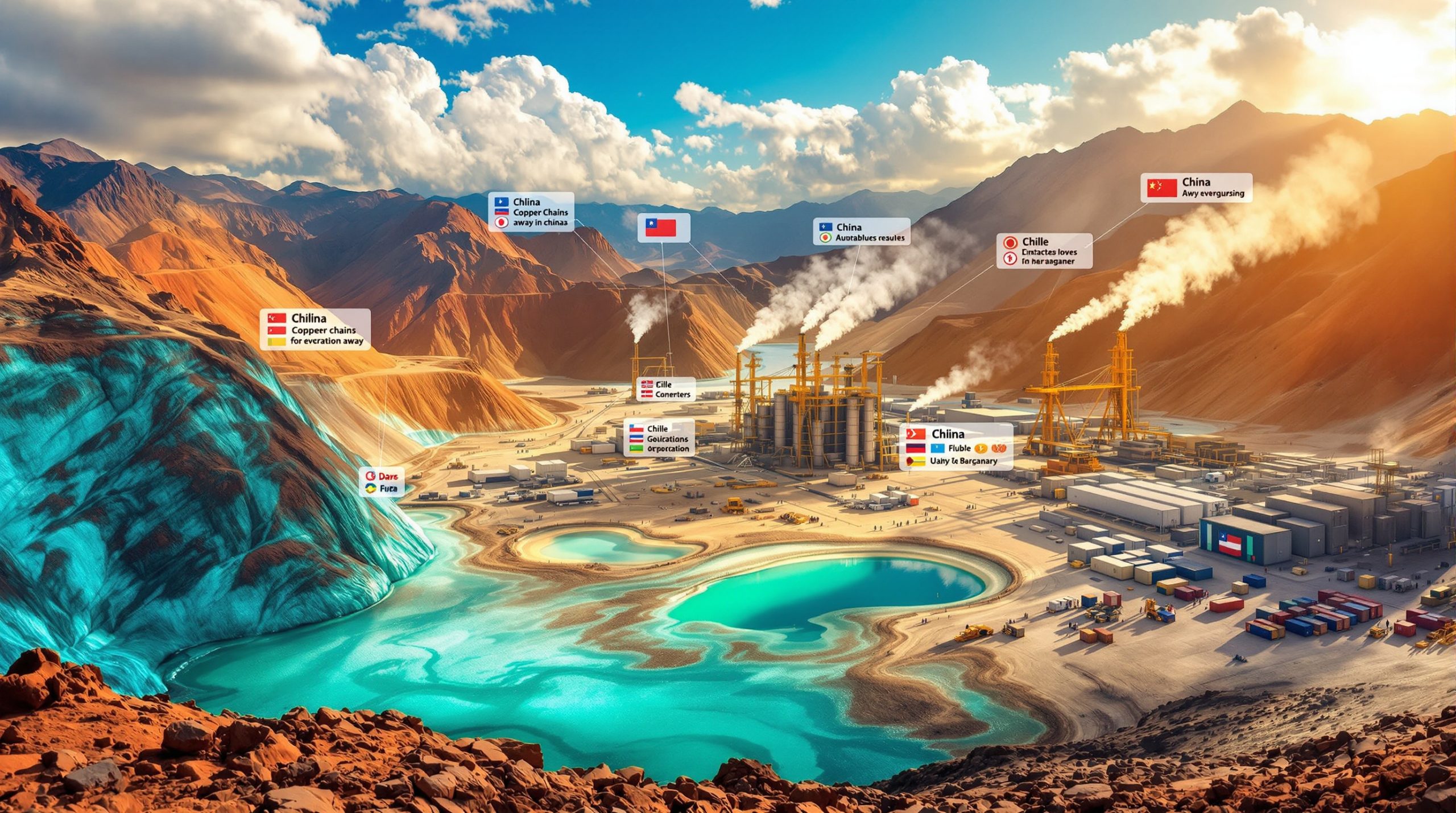Rio Tinto's Copper Production Expansion: Strategic Growth and Market Impact
Rio Tinto's strategic focus on copper production reflects the growing global demand driven by energy transition initiatives, renewable infrastructure development, and technological advancement. As copper becomes increasingly critical for electrification efforts worldwide, the mining giant is positioning itself to capitalize on projected supply shortfalls in the coming decades.
According to the International Energy Agency, copper demand for clean energy technologies alone is expected to more than double by 2040, reaching approximately 30 million tonnes annually. This surge is driven by copper's essential role in renewable energy systems, which require significantly more of the metal than traditional power generation methods.
Battery electric vehicles, which contain approximately 83 kg of copper (nearly four times the amount in conventional combustion engines), represent just one segment of growing demand. Wind farms require between 2.5-6 tonnes of energy transition metals per megawatt, while solar photovoltaic systems need approximately 4-5 tonnes per megawatt.
How Significant is Rio Tinto's Recent Copper Performance?
Q3 2025 Production Highlights
Rio Tinto delivered exceptional third-quarter results in 2025, with copper production reaching 204,000 tonnes—a 10% increase compared to the same quarter in 2024. This growth contributed to an overall 9% year-on-year increase in copper equivalent production across the company's portfolio, demonstrating strong momentum in its copper business segment.
The company's performance reflects its commitment to capitalizing on the growing demand for copper in the global energy transition. With multiple operations contributing to this output, Rio Tinto is steadily establishing itself as a major player in the global copper production forecast.
Key Production Metrics
| Metric | Q3 2025 Performance | Year-on-Year Change |
|---|---|---|
| Copper Production | 204,000 tonnes | +10% |
| Overall Copper Equivalent Production | N/A | +9% |
| Oyu Tolgoi Underground Ramp-up | On track | Expected +50% output boost |
| Bauxite Production | Upgraded guidance to 59-61 million tonnes | Previously 57-59 million tonnes |
| Iron Ore Shipments | 84.3 million tonnes | +6% quarter-on-quarter |
| Aluminum Production | 857,000 tonnes | +6% year-on-year |
These production metrics underscore Rio Tinto's multi-commodity strength, with copper emerging as a standout performer in the recent quarter. The company's ability to deliver growth across several key commodities indicates strong operational execution and effective resource management.
Which Projects Are Driving Rio Tinto's Copper Growth?
Oyu Tolgoi: The Mongolian Powerhouse
The Oyu Tolgoi mine in Mongolia represents Rio Tinto's flagship copper project and a cornerstone of its growth strategy. Located in the Gobi Desert, this world-class deposit ranks among the largest known copper and gold resources globally. The underground expansion is progressing on schedule, with production ramp-up expected to boost copper output by more than 50% in the near term.
The project employs block cave mining, one of the most cost-effective methods for extracting deep, large ore bodies. This technique allows Rio Tinto to efficiently access and recover the valuable resource while managing production costs. The underground development complements the existing open-pit operation, which has been producing since 2013.
Ownership of Oyu Tolgoi is structured with Rio Tinto holding a majority stake through Turquoise Hill Resources (66%), while the Government of Mongolia maintains a 34% interest. This partnership approach has been crucial for advancing the project through various development stages.
Operational Excellence Initiatives
Beyond major project developments, Rio Tinto is implementing operational excellence programs across its copper portfolio to maximize production efficiency and resource recovery. These initiatives complement the company's broader strategic reorganization, which recently introduced a simplified business model focused on core commodities including copper.
Technical innovations in ore processing and mining methods are enabling Rio Tinto to extract more copper from existing operations while reducing environmental impacts. Advanced automation, predictive maintenance, and digital twins of processing plants help optimize recovery rates and reduce operational variability.
How Does Copper Fit Into Rio Tinto's Broader Strategy?
Strategic Business Reorganization
In 2025, Rio Tinto implemented a significant organizational restructuring to streamline operations and enhance shareholder value. The new operating model specifically prioritizes three key segments: iron ore, aluminum, and a combined lithium and copper division. This restructuring reflects the growing strategic importance of copper within the company's portfolio.
CEO Simon Trott emphasized that the reorganization aims to simplify business operations while boosting returns to shareholders. By elevating copper to a core strategic pillar alongside traditional strengths like iron ore, Rio Tinto is signaling its long-term commitment to this critical metal.
Executive Leadership Changes
The company's commitment to copper growth is further evidenced by recent executive team changes designed to support its strategic priorities. CEO Simon Trott has emphasized that these leadership adjustments will help deliver "compelling mid-term production growth" across key commodities, with copper playing a central role.
By aligning executive responsibility with its strategic focus areas, Rio Tinto has created clearer accountability for delivering on copper growth targets. The restructured leadership team brings together operational expertise with strategic vision to drive the copper business forward.
What Market Factors Are Influencing Rio Tinto's Copper Focus?
Global Demand Dynamics
Copper demand continues to accelerate globally, driven by:
- Renewable energy infrastructure requiring substantial copper inputs
- Electric vehicle manufacturing expansion
- Power grid modernization projects
- Data center construction and digital infrastructure growth
- Industrial automation and smart technology adoption
The metal's excellent conductivity properties make it irreplaceable in many applications critical to decarbonization efforts. As countries worldwide pursue aggressive climate targets, copper demand is projected to outpace supply for the foreseeable future.
Price Environment and Market Outlook
While specific copper price data wasn't included in Rio Tinto's Q3 report, the broader commodities market has shown resilience. Iron ore prices, for example, rebounded to a seven-month high of $108 per dry metric tonne during the same period, indicating strength in the industrial metals sector generally.
Copper's fundamental supply-demand imbalance supports a positive long-term copper price prediction. Industry analysts project potential supply deficits emerging in the mid-2020s as demand from energy transition applications accelerates while few new large-scale copper mines are being developed.
How Does the Copper Ramp-up Compare to Other Rio Tinto Operations?
Multi-Commodity Production Performance
While copper growth is impressive, Rio Tinto continues to deliver strong results across its diversified portfolio:
- Iron ore shipments from the Pilbara reached 84.3 million tonnes in Q3 2025, representing the second-highest third quarter since 2019
- Bauxite production set consecutive quarterly records, prompting guidance upgrades
- Aluminum production increased 6% year-on-year to 857,000 tonnes
This balanced performance across multiple commodities provides Rio Tinto with stability through market cycles. The company's ability to generate strong cash flows from established operations helps fund the capital-intensive development of copper projects.
Simandou Project Milestone
Beyond copper, Rio Tinto achieved a significant milestone at its $6.2 billion Simandou iron ore project in Guinea, beginning the commissioning of its mine-to-rail-to-port system with the first ore loading in October 2025. Initial shipments are expected in November, with full capacity of 60 million tonnes per year to be reached over the next 30 months.
The scale of investment in Simandou underscores Rio Tinto's continued commitment to iron ore as a core business, even as it increases focus on copper. This multi-commodity approach balances near-term cash flow with long-term strategic positioning for energy transition materials.
What Are the Operational Challenges in Copper Production Expansion?
Technical Complexities
Ramping up copper production presents several operational challenges:
- Managing underground mining complexities at Oyu Tolgoi, including geotechnical considerations in block cave mining
- Optimizing ore processing and recovery rates for varying mineral compositions
- Balancing water management in Mongolia's water-stressed Gobi Desert region
- Addressing power supply requirements for expanded operations
- Navigating labor market constraints in remote mining regions
Block cave mining at Oyu Tolgoi requires precise control of subsidence and draw rates to maintain stability while maximizing ore recovery. The technical complexity of this mining method demands specialized expertise and careful monitoring systems.
Risk Mitigation Strategies
To address these challenges, Rio Tinto is implementing comprehensive risk management approaches including:
- Advanced technological solutions for underground mining, including automated equipment
- Investment in workforce development and training programs
- Sustainability initiatives to minimize environmental impact
- Strategic partnerships with local communities and governments
- Long-term infrastructure development planning
The company's decades of experience in complex mining operations provides a foundation for successfully managing these challenges. Rio Tinto's technical capabilities and resource base position it to overcome operational hurdles in achieving its copper growth ambitions.
What Is the Outlook for Rio Tinto's Copper Production?
Near-Term Production Guidance
Rio Tinto has indicated that its copper segment is on track to achieve results at the higher end of its full-year guidance for 2025, reflecting strong operational performance and successful project execution. The continued ramp-up at Oyu Tolgoi is expected to be the primary driver of near-term production growth.
As stated by CEO Simon Trott, the company is "well positioned to deliver compelling mid-term production growth" across its portfolio, with copper playing an increasingly important role in future output.
Long-Term Growth Trajectory
The company's copper production is positioned for sustained growth over the coming years, supported by:
- Continued ramp-up of the Oyu Tolgoi underground mine
- Operational optimization across existing assets
- Potential new project developments and acquisitions
- Technology implementation to improve recovery rates
- Strategic exploration programs to expand the resource base
While specific tonnage targets beyond 2025 haven't been publicly disclosed, the substantial investment in Oyu Tolgoi and strategic prioritization of copper indicate expectations for significant production increases in the coming years.
How Does Rio Tinto's Copper Strategy Compare to Industry Peers?
Competitive Positioning
Rio Tinto's copper expansion strategy positions the company alongside other major miners who are similarly increasing their exposure to this critical metal:
- BHP has designated copper as a primary growth commodity
- Glencore maintains significant copper operations globally
- Anglo American has emphasized copper in its portfolio
- Freeport-McMoRan continues as a copper-focused producer
Rio Tinto's advantage lies in its combination of established operations and significant growth projects, particularly the world-class Oyu Tolgoi development. The company's strong balance sheet and technical capabilities provide it with options for organic growth as well as potential acquisitions.
While specific comparative production data wasn't detailed in the latest report, Rio Tinto's strategic focus on copper aligns with industry-wide recognition of the metal's crucial role in the energy transition.
What Are the ESG Considerations in Rio Tinto's Copper Expansion?
Sustainability Commitments
As Rio Tinto expands copper production, the company must balance growth objectives with environmental and social responsibilities:
- Water conservation initiatives in water-stressed regions like Mongolia's Gobi Desert
- Energy efficiency and renewable power integration
- Community engagement and development programs
- Biodiversity protection in mining areas
- Greenhouse gas reduction targets across operations
Copper mining, particularly in sensitive environments, requires careful management of environmental impacts. Rio Tinto's approach to sustainable development includes comprehensive environmental management systems and regular public reporting on performance.
Stakeholder Engagement
Successful copper growth requires maintaining strong relationships with:
- Host governments and regulatory authorities
- Local communities near mining operations
- Indigenous peoples with traditional connections to land
- Environmental organizations and advocacy groups
- Investors focused on ESG performance metrics
The company's experience with community relations provides a foundation for addressing social license challenges associated with copper development. Transparent engagement with stakeholders has become increasingly important for advancing major projects in the mining sector.
What Does Rio Tinto's Copper Expansion Mean for Investors?
Investment Implications
Rio Tinto's strategic focus on copper carries several implications for investors:
- Diversification beyond traditional iron ore revenue dependence
- Exposure to energy transition and electrification trends
- Potential for improved margins through higher-value commodities
- Long-term growth prospects aligned with global megatrends
- Balanced portfolio approach to commodity cycle management
The company's move to elevate copper's strategic importance reflects a recognition of changing market dynamics and the opportunity to capture value from growing demand for copper investment outlook.
Financial Performance Indicators
Investors should monitor several key metrics as the copper expansion progresses:
- Production volumes and unit costs
- Capital expenditure efficiency
- Free cash flow generation
- Return on invested capital
- Progress against project milestones and timelines
As stated by CEO Simon Trott, the company aims to "continue to deliver further shareholder value through operational excellence, simplification and discipline on performance and capital investment." This focus on capital discipline is particularly important in the context of large-scale copper developments, which can be capital-intensive.
Strategic Significance of Rio Tinto's Copper Ambitions
Rio Tinto's accelerated copper production represents a fundamental strategic pivot for the global mining giant. By leveraging its operational expertise, financial strength, and world-class assets like Oyu Tolgoi, the company is positioning itself to capitalize on the structural growth in copper demand driven by global electrification and decarbonization trends.
The recent production results demonstrate that this strategy is gaining momentum, with significant year-on-year growth and positive outlook for continued expansion. As copper's role in the global economy continues to expand, Rio Tinto's increased focus on this critical metal appears well-timed to deliver long-term value for shareholders while contributing essential materials to the energy transition.
FAQ: Rio Tinto's Copper Production Strategy
How much copper does Rio Tinto currently produce?
Based on Q3 2025 results, Rio Tinto produced 204,000 tonnes of copper, representing a 10% increase from the same period in 2024.
Which is Rio Tinto's most important copper asset?
The Oyu Tolgoi mine in Mongolia is Rio Tinto's flagship copper project, with its underground expansion expected to boost copper output by more than 50%.
Is Rio Tinto primarily a copper company?
No, Rio Tinto maintains a diversified portfolio with iron ore remaining its largest revenue generator, though copper is becoming increasingly strategic within the company's operations.
How does copper production compare to iron ore in Rio Tinto's portfolio?
Iron ore shipments reached 84.3 million tonnes in Q3 2025 compared to 204,000 tonnes of copper, highlighting the scale difference while demonstrating growth in both segments.
What is Rio Tinto's competitive advantage in copper?
Rio Tinto leverages its global operational expertise, financial strength, and world-class assets like Oyu Tolgoi to compete effectively in the copper market. The company is also increasingly implementing AI in mining operations to improve efficiency and productivity.
Searching for the Next Major Copper Discovery?
Stay ahead of the market with Discovery Alert's proprietary Discovery IQ model, which instantly notifies investors about significant ASX mineral discoveries, turning complex data into actionable insights. Visit the Discovery Alert discoveries page to understand why major mineral discoveries can lead to substantial returns and begin your 30-day free trial today.




